![]()
![]()
![]()
Use LEFT and RIGHT arrow keys to navigate between flashcards;
Use UP and DOWN arrow keys to flip the card;
H to show hint;
A reads text to speech;
96 Cards in this Set
- Front
- Back
|
ABD history |
• general indicators of illness, med/surg history • NEEDS • tanner stages; expect menses in 4 & 5 • trauma history, e.g. hit in belly • child v. parent • chronology • immunizations, esp. hep A&B • PQRST |
|
|
KUB |
**flat plate for constipation, do rectal exam instead for constipation to avoid x-ray exposure |
|
|
ABD anatomy |
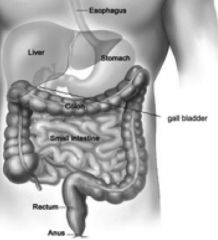
**think about referred pain, palpate above and below area of complaint
LUQ- pancreas, spleen RUQ- gallbladder, liver LLQ- colon, intestine, L ovary RLQ- appendix, intestine, R ovary |
|
|
dance's sign |
**RLQ for retractions >> check for obstruction, e.g. intussusception, constipation |
|
|
ABD physical |
• inspection • non-touching maneuvers • auscultation • palpation • non abdominal area • rectal & genitatlia |
|
|
scratch test |
**never touch belly in pain w/o performing scratch test
• find edge of liver by scratching up lightly • hepatosplenomegaly; avoids rupture • important to do in sickle cell kids
|
|
|
palpate kidney |
1/ place L hand posteriorly below R 12th rib 2/ lift upwards trying to displace R kidney anteriorly 3/ palpate deeply w/ R hand on anterior abdominal wall 4/ patient takes deep breath 5/ feel for lower pole of kidney as it decends and try to capture b/w hands 6/ have patient release breath & slowly release the kidney 7/ L kidney is seldom palpable
**feel both sides, midaxillary |
|
|
CVA tenderness |
>>kidney infection, e.g. pyelonephritis, perinephric abscess |
|
|
PE red flags |
guarding-- • peritonitis, appendicitis, cholecysitis
point tenderness-- • appendicitis, cholecystitis
asymmetry-- • appendicitis absess, tumor
no bowel sounds-- • pertitonitis, infarcted bowels
palpable mass-- • tumor, cyst, intussusception
nutritional status-- • weight, height, edema, anemia • children should not lose weight
extra intestinal features-- • arthritis, skin, eyes
abdominal distention-- • peritonitis, obstruction
visible bowel loops-- • intussusception, obstruction
high pitched bowel sounds-- • obstruction |
|
|
acute v. subacute abdominal pain |
acute-- • slow or rapid onset • steadily builds • may relate to event • v/d, anorexia • guarding
subacute-- • onset difficult to remember • not acutely ill • allows examination • vague, difficult to localize |
|
|
causes of epigastric pain |
• PUD • GERD • gallbladder disease • pancreatitis • trauma • idiopathic |
|
|
causes of periumbilical pain |
• functional abdominal pain • abdominal migraine • strep pharyngitis • gastroenteritis • appendicitis • carbohydrate intolerance • lactase deficiency |
|
|
chronic abdominal pain |
• a/w unpopular event & resolves spontaneously • pain out of proportion to PE findings • cannot be localized • does not wake child • normal labs |
|
|
T/F. Anxiety can cause hypervisceral gut. |
True; pain can be real to child. |
|
|
T/F. The closer pain is to umbilicus, the more likely it is to be organic. |
False; inorganic
The further away from umbilicus the higher the chance of pathology. |
|
|
top missed diagnoses |
1/ brain tumor 2/ meningitis 3/ appendicitis |
|
|
R v. L quadrant pain |
**ovarian torsion can be both
RLQ-- • appendicitis • PID • ectopic pregnancy • mittelschmerz • R lower lobe pneumonia • iguinal hernia • iliopsoas abscess
LLQ-- • constipation • R ovarian testicular pain |
|
|
causes of suprapubic pain |
• UTI • constipation • urinary retention • hydrometrocolpos a/w imperforated hymen |
|
|
non-abdominal causes of ABD pain |
• pneumonia due to visceral inervation • strep pharyngitis mimics appendicitis • reproductive tract disease • diabetic ketoacidosis, e.g. tachypnea, serum amylase may be elevated • sickle cell- vasoocclusive crisis, gallstone formation |
|
|
abdominal pain alarms |
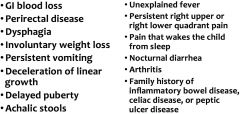
IBD- ashkenazi jews, arthritis |
|
|
history red flags |
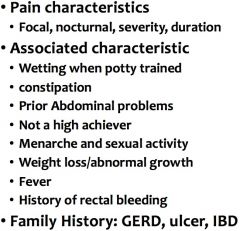
|
|
|
non worrisome ABD pain |
• undigested food in stool • green stool, e.g. fruit rollies • pain resolves |
|
|
corn test |
**intestinal transit time
<12 hrs- prone to diarrhea ~24 hrs- normal >48 hrs- constipation |
|
|
appendicitis |
**pain precedes vomiting
• pain begins as poorly localized, as appendix swells >> pain fibers in parietal peritoneum are stretched • n/v; vomiting 1-2x • normal stool • tenderness @ mcburney's point • fever, leukocytosis • 80% burst by 48 hours >> peritonitis |
|
|
various position of appendix |
**appendix hangs off cecum and can be in various positions
• ileocolical • cecalis anterior • cecalis posterior • R ilealis • R colicus • A apendicular |
|
|
malformation of cecum |
** if non-rotational >> always L of abdominal cavity; malrotation of cecum remains below pylorus
• subhepatic- below liver • mobile- not fixed in retroperitoneum • hyperrotation- directly @ L colic flexure |
|
|
T/F. CT scan is the gold standard to diagnose appendicitis. |
True |
|
|
appendicitis by age |
toddler-- • fever, vomiting • intermittent pain, reffered to R hip • can be localized or generalized
school age-- • pain, comiting, fever • pain w/ walking, movement • abdominal wall tenderness- focal, RLQ • involuntary guarding |
|
|
appendicitis MANTREL |
M- migration of pain A- anorexia N- n/v T- tenderness RLQ R- rebound tenderness E- elevated temp L- leukocystosis |
|
|
acute abdomen factors |
• bilious vomiting • abdominal tenderness, mass • distention • obstipation • feeding intolerance • edema of abdominal wall • crying, irritable • bloody stool • fever, hypothermia • omphalitis • severe pain |
|
|
appendicitis signs |
1/ psoas 2/ obturator 3/ rebound 4/ rovsing 5/ markle jar heel test / heel strike |
|
|
psoas sign |
• child in supine position • R hand above knee & direct child to raise leg against pressure • OR drop child's R leg over exam table |
|
|
obturator sign |
• flex child's R thigh @ hip w/ knee bent • rotate leg internally @ hip
>>pain in internal/external rotation of flexed thigh |
|
|
rovsing's sign |
pain in RLQ w/ L-sided pressure |
|
|
markle jar heel test |
"bunny hop"
• up on toes, down hard on heels • have patient jump up & down |
|
|
rebound |
**do not perform w/ young child |
|
|
cholecystitis |
**gallbladder infection • (+) murphy sign • low grade dull pain, ocassionally sharp • gallbladder can be found in obese children
|
|
|
murphy's sign |
temporary inspiratory arrest w/ palpation of R subcostal margin |
|
|
T/F. Gallbladder is located abve the liver. |
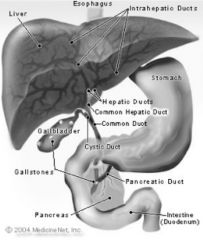
False; below |
|
|
pancreatitis |
**lipase elevation >> amylase elevation
• most common cause is trauma • side effect of HIV meds, alcohol, biliary anomalies, IBD, or pancreatic duct • upper ABD or periumbilicial pain radiating to back • ileus, distention, ascites • hypercalcemia |
|
|
nonalcoholic steatohepatitis v. nonalcoholic fatty liver disease |
**strong association w/ obesity **liver enzyme elevation
NASH-- • fat in liver w/ inflammation • leads to cirrhosis
NAFLD-- • fat in liver w/o inflammation |
|
|
T/F. Hispanic children have the highest risk for fat in the liver. |
True; may need transplant |
|
|
gastroenteritis |
• increased bowel sounds • pain prior to vomiting >> feels better after vomiting |
|
|
vomiting in children |
• infections • cough • ICP • food allergy • achalasia • GERD • poisoning meds • psychogenic metablic DO • cyclic vomiting • eosinophilic esophagitis |
|
|
vomit color |
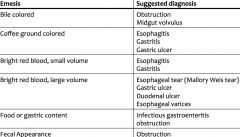
midgut volvulus- intestine twisted around itself |
|
|
mallory-weiss |
tear in mucosal layer @ junction of esophagus and stomach |
|
|
hydration assessment |
**important if complaints of diarrhea, vomiting, or decreased oral intake
be aware of -- • voiding pattern- should void q 8hours • level of activity • heart rate |
|
|
shock |

to rehydrate >> teaspoon q 5 mins, increase if child tolerates |
|
|
eosinophilic esophagitis |
• chronic, immune/antigen-mediated esophageal disease • esophageal dysfunction & inflammation • isolated to esophagus
causes-- • genetic • susceptibility |
|
|
eosinophilic esophagitis s&s |
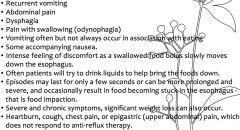
|
|
|
eosinophilic esophagitis treatment |
corticosteroids |
|
|
eosinophilic esophagitis diagnostic tool |
endoscopy w/ biopsy |
|
|
stool appearance |
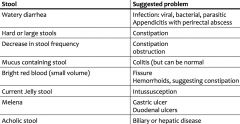
alcoholic stool is pale |
|
|
bristol stool chart |
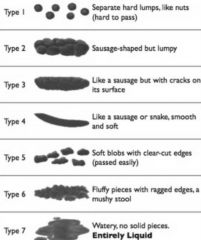
3/4 is normal |
|
|
functional gastrointestinal disorder |
**must include all the following at least once a week for at least two months prior to diagnosis
1/ continuous or episodic ABD pain 2/ insufficient criteria for other functional GI DO 3/ no evidence of inflammatory anatomic, metabolic, or neoplastic process that explains symptoms |
|
|
What is the best work-up for functional gastrointestinal disorder? |
**f/u if child is growing well, million $ lab not needed >> can do CBC, sed-rate, urianalysis |
|
|
functional abdominal pain risk factors |
• family history of anxiety or depression • behavioral inhibition, e.g. internalizer • limited exposure to non-family caregivers • limited participation in activities outside family • overprotection
other situations-- • move, new school • parental separation • divorce • death of family members |
|
|
treatment for functional abdominal pain |
• biofeedback to help learn how to control • self-hypnotism • therapy |
|
|
irritable bowel syndrome |
**abnominal discomfort/pain a/w 2 or more of the following at least 25% of the time--
• onset a/w change in stool frequency • onset associated w/ change in stool form • no evidence of any inflammatory, anatomic, metabolic, or neoplastic process |
|
|
functional dyspepsia |
• persistent / recurrent pain / discomfort centered in upper abdomen • not relieved by defecation or a/w onset of change in stool frequency or stool • no evidence of inflammatory, anatomic, metabolic, or neoplastic process |
|
|
H. pylori |
• gram (-) • transmitted by fecal oral & oral-oral route • prevalence increases w/ age • more common in developing countries
**recommendation is not to treat unless there is family history but it is up to provider's discretion |
|
|
bilious emesis |
GREEN & usually indicate obstruction |
|
|
causes of obstruction |
infancy-- • feeding problems w/ bilious vomiting • FTT w/ feeding intolerance, e.g. malrotation w/ volvulus
school-aged child-- • adhesions from previous surgeries |
|
|
pyloric stenosis |
**narrowing of pyloric valve; hypochloremic metabolic alkalosis
• familial • 5:1 male • non-bilious vomiting • hungry 30-60 minutes later |
|
|
infant dyschesia |
**failure to coordinate relaxation of pelvic floor & external sphincter; most children learn by 3-4 months
• grunts & groans • can take 20 minutes for infants to get stool out • very soft stool |
|
|
intussusception |
• invaginating or telescoping of one portion of bowel into itself • produces obstruction & vascular compromise • most frequent cause of mechanical obstruction in infants & toddlers • 50% of patients are < 1 y/o • 2:1 males • viral association |
|
|
intussusception s&s |
• most commonly seen in RUQ • current jelly stool- maroon • vomiting • intermittent abdominal pain w/ palpable sausage shaped mass • dance's sign- concavitity in RLQ • body protects itself by releasing endorphins >> child may present obtunded |
|
|
ileocolic intussusception |
**telescoping pulls bowel structures upward in abdomen
• diarrhea/fever • bloody stool may take a while to develop |
|
|
intussusception diagnosis & treatment |
diagnosis-- • difficult • barium enema is 100% diagnositc
treatment-- • pneumatic reduction >> (-) sedation, pain, morbidity • hydrostatic reduction • operative reduction |
|
|
hirschsprung's disease |
**aganglionic megacolon
• no stool in first 48 hours of life • need manipulation to pass stool • stool is pungent, either occasional and massive or frequent and pellet like • FTT • marked abdominal distention • vomiting w/ lethargy • abnormal rectal anatomy, e.g. anterior placement or against scrotum • abnormal neuro exam |
|
|
hirschprung's disease PE |
newborn-- • constipated w/ distended soft abdomen • normal or hyperactive bowel sounds • ill; more distended w/o peritoneal signs unless perforation, lethargic, fever, tachy, hypotension
older infants & children-- • chronically distended, non-tender abdomen • large fecal masses on L side |
|
|
hirschsprung's disease rectal exam |
**ampulla empty; exlosive evacuation of stool/gas upon removal slight pressure in newborn v. normal tone in older infants + |
|
|
constipation |
• toddler who tries to hold stool & fails to relax external sphincter • hirschsprung's has abnormality in internal sphincter relaxation • abnormal linear growth w/ constipation >> hypothyroidism |
|
|
GI bleeding |
hematemesis-- • vomiting of blood or blood per rectum
malena-- • dark or back tarry stools from upper tract
hematochezia-- • maroon stools • indicates distal GI source or short transit time from briskly bleeding proximal source |
|
|
mimics of GI bleeding |
**red candies/dye, juices, beets
black stool-- • peptobismol • iron, spinach • blueberries • licorice |
|
|
T/F. Newborn hematemesis can be caused by swallowing of maternal blood during delivery. |
True |
|
|
APT test |
**mix emesis w/ 1% sodium hydroxide >> fetal hemoglobin remains pink >> bright red maternal hemoglobin turns brown |
|
|
causes of upper GI bleeding |
• stress • vascular malformation • gastric/esophageal duplication • hemorrhagic gastritis; newborn needs K+ shot • esophagitis • varices from portal HTN • bleeding diathesis from hemorrhagic disease of newborn |
|
|
causes of lower GI bleeding |
juvenile polyps-- • proximal to transverse colon • bleeding w/ sloughing of polyps • painless, rarely massive • gardner's syndrome or familial polyposis >> (+) risk of colon cancer
anal fissure-- • infants- formulas, rice cereal • toddlers- withholding poop while toileting • painless • worry about crohn's disease in older children |
|
|
meckel diverticuli |
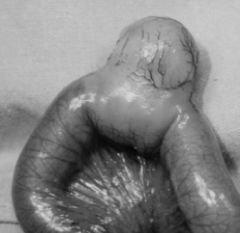
• most common source of significant lower GI bleeding in children, esp. preschoolers • bleeding results from pepetic ulceration of ileal mucosa from HCL secreted from ectopic gastric mucosa within diverticulum • painless but can be massive |
|
|
malrotation of volvulus |
**abnormal fixation of bowel mesentery w/ twisting around mesenteric artery • feeding problems >> FTT • painful distended abdomen • bilious vomiting • blood in stool |
|
|
ulcerative colitis v. crohn's disease |
ulcerative colitis-- • diffuse, continuous superficial inflammation • edema, shallow ulceration, & small pseudopolyps in rectum & colon
crohn's disease-- • focal asymmetrical inflammation anywhere in GI tract • most common in terminal ileum, proximal colon, & ileocecal junction |
|
|
ulcerative colitis |
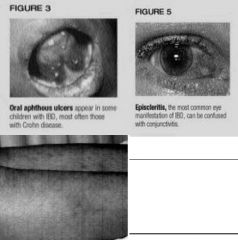
• most commonly diagnosed 15-30 years • acute bloody diarrhea • cramping • tenesmus • pallor • growth retardation
extraintestinal manifestation-- • arthralgia • uveitis • oral ulceration, e.g. apthous ulcers • growth retardation • liver disease
skin manifestation-- • erythema nodosum • pyoderma granulosum |
|
|
crohn's disease |
• weight loss • ABD pain, usually RLQ • diarrhea, can be bloody • fever • anal skin tag • perianal ulcerations |
|
|
T/F. Crohn's disease has the same extra-intestinal manifestation as ulcerative colitis. |
True |
|
|
T/F. Neuroblastoma is the most common tumor under one year old. |
True
presenting s&s vary w/ site of primary tumor-- • 2/3 are adrenal • sympathetic paraspinous ganglia • posterior mediastinum • head and neck >> racoon eye |
|
|
neuroblastoma history |
• vasoactive intestinal peptide (VIP) • watery diarrhea w/ abdomen, distention, & electrolyte imbalance • opsoclonous-myoclonus • catecholamine excess; flushing, tachycardia, headache, HTN more common if renal |
|
|
head/neck v. thoracic neuroblastoma |
head/neck-- • visual changes • exopthalmos • horner's syndrome; ptosis, meiosis, anhydrosis • cerebellar ataxia
thoracic-- • if dumb bell extension into spine >> neurological abnormalities, cough, SOB |
|
|
periorbital ecchymosis |
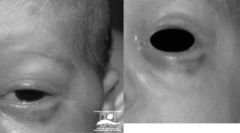
aka racoon eye |
|
|
abdominal mass |

crosses midline of thoracic cavity |
|
|
heterochromia iridis |

|
|
|
neuroblastoma v. wilm's tumor |
neuroblastoma-- • rapidly growing tumor; usually found @ stage IV • sick child
wilms tumor-- • painless, child appears well |
|
|
Which two heriditary tumors are the most common? |
• retinoblastoma • wilm's tumor |
|
|
wilm's tumor |
**don't touch belly >> will cause metastasis
• hard, fixed, firm w/ irregular border; does not usually cross midline • asymptomatic until large • pressure effects >> early satiety • vomiting • crampy abdominal pain • HTN & microhematuria |
|
|
What can a varicocele in a boy with L sided tumor indicate? |
renal vein occlusion |
|
|
pelvic neuroblastoma |
• urinary frequency • incontinence • lower extremity vascular changes |

